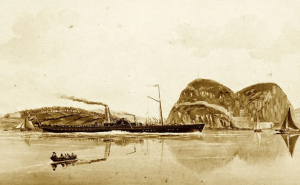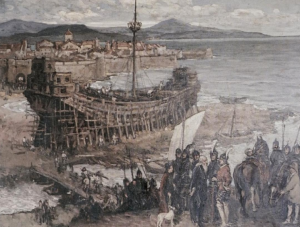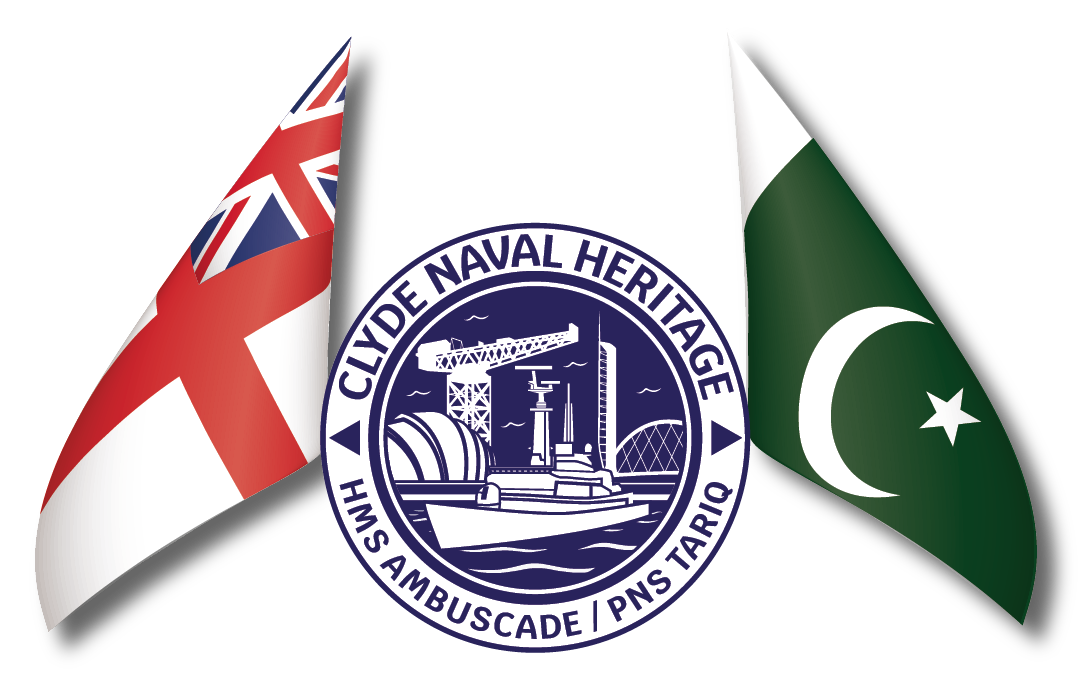Dumbarton Castle, perched on a volcanic rock overlooking the convergence of the River Leven and the River Clyde, played a significant role in the early development of shipbuilding in the region. Strategically positioned at the mouth of the River Leven, it served as a naval stronghold and a key shipbuilding centre from the medieval period through the 17th century. The castle’s shipyards were central to Scotland’s early naval activities and were instrumental in producing vessels for both defensive and commercial purposes.
Strategic Importance of Dumbarton Castle
Dumbarton Castle’s location made it a natural defensive and administrative centre, controlling access to the River Clyde and acting as a gateway to the western seaboard of Scotland. Its position allowed it to oversee maritime traffic and protect the approaches to Glasgow and the hinterland. During the medieval period and beyond, control of the Clyde was crucial for the Scottish Crown, as it provided access to trade routes and a means of projecting naval power along the western coast.
The castle, with its commanding view and access to the sheltered waters of the Clyde estuary, provided an ideal location for constructing and outfitting ships. During times of conflict, the sheltered bays around Dumbarton Rock allowed for the safe harbouring of vessels, while the castle itself offered protection and storage for supplies, weapons, and materials needed for ship construction.

Early Naval Shipbuilding at Dumbarton Castle
The role of Dumbarton Castle in shipbuilding became particularly significant during the reign of King James IV (1488-1513). James IV was one of Scotland’s most ambitious kings, with a keen interest in naval affairs. He sought to expand and modernize the Scottish fleet to enhance the kingdom’s maritime capabilities and defend against English and foreign threats. Dumbarton Castle became a focal point for these efforts, serving as both a construction site and a logistical base for outfitting naval vessels.
One of the earliest documented shipbuilding projects at Dumbarton Castle was the construction of galleys and small warships designed for coastal defence and raiding operations. These vessels were critical for defending Scotland’s western coast against piracy and English incursions and for projecting Scottish power into the Irish Sea and beyond.

The Great Michael and the Expansion of Shipbuilding
The most famous ship associated with Dumbarton Castle’s shipyards is the Great Michael, one of the largest warships of its time. Commissioned by King James IV in 1511, the Great Michael was a 240-foot-long carrack, equipped with over 300 cannons and capable of carrying a crew of up to 1,000 men. Though the hull of the ship was constructed at Newhaven on the Firth of Forth, it was at Dumbarton Castle that the ship was outfitted and made seaworthy. The castle’s shipyards provided the space and facilities needed for the ship’s final preparations before it set sail.
The construction and outfitting of the Great Michael were symbolic of the aspirations of the Scottish Crown to establish a powerful navy capable of rivalling those of England and continental European powers. The ship required significant resources, including Scottish timber, iron, and manpower, much of which came from the regions surrounding the Clyde and Leven.

The project demonstrated the ability of the Clyde’s early shipyards to support large-scale shipbuilding endeavours and positioned Dumbarton as a key player in Scotland’s maritime strategy. Though the Great Michael ultimately proved too costly to maintain and was sold to France after James IV’s death, the project established Dumbarton’s reputation as a centre for complex shipbuilding projects and naval outfitting.
Shipbuilding Activities in the 16th and 17th Centuries
Throughout the 16th and 17th centuries, Dumbarton Castle continued to serve as a base for naval and merchant shipbuilding. The shipyards at Dumbarton produced a variety of vessels, including galleys, barks, and merchant ships, which were used for both military and commercial purposes. The castle’s shipbuilders were known for their skill in constructing sturdy, manoeuvrable vessels suitable for navigating Scotland’s often treacherous coastal waters.
During this period, Dumbarton Castle also served as a base for the repair and refitting of ships. The sheltered bays around Dumbarton provided safe anchorage for damaged vessels, which could be brought ashore for repairs to their hulls, masts, and rigging. This role was particularly important during times of war or conflict, when the Scottish navy needed to maintain a fleet ready for action.
Support of the Royal Navy and Role in Scottish Maritime Défense
Dumbarton Castle’s role in supporting Scotland’s maritime defences extended beyond shipbuilding. The castle’s strategic location made it an ideal site for storing naval supplies and munitions, which could be distributed to ships operating in the Clyde and along the western coast. The castle’s armouries held cannons, gunpowder, and other weapons that were used to arm ships constructed or outfitted at its shipyards.
As the political landscape of the British Isles changed, Dumbarton Castle adapted to new roles. Following the Union of the Crowns in 1603, which saw Scotland and England united under a single monarch, Dumbarton Castle continued to serve as a military and naval base, though its prominence in shipbuilding declined as other centres, such as Port Glasgow and Greenock, rose to prominence. Nonetheless, the castle remained a key component of Scotland’s maritime defence network well into the 17th century.
Decline of Dumbarton’s Shipbuilding Role
By the late 17th century, the focus of shipbuilding on the Clyde had shifted away from Dumbarton Castle to more dedicated shipyards further downriver, particularly in Port Glasgow and Greenock. The development of these newer shipyards was driven by the needs of the expanding transatlantic trade and the growing complexity of shipbuilding. As larger, purpose-built shipyards emerged, Dumbarton’s role in ship construction diminished, and the castle transitioned into a more defensive and administrative role.
Despite this decline, Dumbarton Castle’s shipbuilding legacy endured. The skills and techniques developed at Dumbarton were passed down to subsequent generations of shipbuilders along the Clyde. The castle’s early contributions to naval shipbuilding laid the groundwork for the Clyde’s later emergence as a world-renowned shipbuilding centre during the 19th and 20th centuries.
Legacy of Dumbarton Castle in Clyde Shipbuilding History
Dumbarton Castle’s influence on shipbuilding along the Clyde is an important, though often overlooked, chapter in the river’s maritime history. As one of the earliest centres of organized shipbuilding activity in the region, the castle helped establish the Clyde as a hub for naval and maritime construction long before the rise of industrial shipyards. Its shipyards supported Scotland’s naval ambitions during the turbulent years of the 16th and 17th centuries and served as a precursor to the Clyde’s later dominance in shipbuilding.
Today, Dumbarton Castle stands as a historical landmark, overlooking a river that once bustled with the activity of shipbuilders and sailors. Its role in shaping the early shipbuilding industry on the Clyde is remembered as a testament to the strategic and economic importance of the region in Scotland’s maritime heritage.

